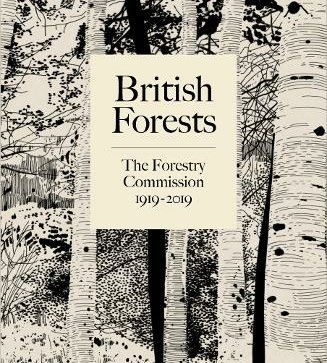From Living Woods issue 53
PROFESSOR JULIAN EVANS reviews a commemorative history
of the Forestry Commission
 BRITISH FORESTS: THE FORESTRY
BRITISH FORESTS: THE FORESTRY
COMMISSION 1919-2019
Profile Books Ltd
Hardback 256 pages £25
ISBN 978-1788163132
Celebrating the Forestry
Commission’s centenary always
required a book and what is on
offer is an interesting compendium. It is
in three parts: history, then six chapters
called ‘Among the trees’ ranging from
silviculture to arts and recreation, and
a final part comprising pen-pictures of
all the major public forests throughout
Great Britain. Ian Gambles, Head of
Forestry England, is the overall editor. In
his Introduction he hopes the book will
share something of the story, will outline
the challenges faced, and ‘. . . invite you in,
to visit and enjoy the nations’ forests, to
see and explore more.’
British Forests: The Forestry Commission
1919-2019 is well written and a pleasure
to read. More perhaps could have been
made of the Commission’s considerable
achievements: in the Introduction
woodland cover is said to have doubled
since 1919 whereas at over 13% today
it has nearly tripled. And our urban trees
and forests are not only ‘the lungs of the
city’, but air filters too.
The account of the ‘Formation of the
Forestry Commission’ is fascinating. It
reminds us that all great endeavours
are a mix of vision, determination
and good fortune. The next 71 pages
detailing the Commission’s history,
decade by decade, are a delight: action,
anecdote, and activity are traced in
sufficient detail to inform and entertain.
Establishing Forest Parks in the 1930s,
long before National Parks, the
contribution of 6,000 lumberjills to the
war effort, the introduction of felling
licences in the1950s, Sylvia Crowe’s
impact on landscaping a decade later,
two attempted privatisations, and the
ramifications of devolution are all there.
Part 2 begins with Silviculture and is
as fine a summary as any, with pleasing
reference to the Beddgelert high altitude
species trial, coping with inhospitable
soils, the suite of ‘forest gardens’ (tree
collections), and other trials and
experiments which so informed practice.
Broadleaves and squirrels get appropriate
mention, as do the critics of the forests
of exotic monoculture that dominated
the immediate post-war period. This
chapter also presents the challenges of
today and, as with much of the book,
weaves in modern updates when tracing
the history or first introduction of an
idea or practice.
The Habitats chapter really tells the
story of a ‘Damascene conversion’,
to quote the authors, namely how
plantation conifer-driven forestry evolved
in a generation to more sympathetic
approaches recognising site history,
habitats, ancient woodland ecology, the
place of broadleaves, the environment
and the multitude of interests public
forests attract. This is followed by a
chapter entitled Forest Science and
underscores the role research played
for example in the development of
successful afforestation, the invention
of tree shelters (translucent tubes) so
useful for small-scale plantings, and the
place of inventories of Britain’s forest
estate that have proved so valuable.
It concludes with the authors’ list of
‘great’ experiments – I looked in vain for
Crumbland, Gwent where free growth of
oak has been (and still is) so eloquently
demonstrated over 70 years.
Forest Hazards rightly gets a chapter
to itself, detailing fires, storms and
most notably pests and diseases with
the principal threats summarised. It
indicates just how vulnerable our trees
and forests are and how the situation is
getting worse owing to climate change
and the woefully under-regulated
worldwide trade in plant material.
Arts and Recreation also have their
own chapter which reflects priorities in
the 21st century. Indeed most people’s
love for the public forest estate is its
best guarantor for the future. But just
reading this chapter bringing together
theatre, sculpture, hiking trails, car
rallies, mountain biking, holiday cabins,
‘go ape’ and much more shows that
public funds for public good is already
embedded in Commission thinking.
Why conclude part 2 with ‘Cities’? The
reason, as British Forests explains, is
the Commission’s unsung contribution
through community forests, the hosting
of DEFRA’s Arboricultural Information
and Advisory Service at Alice Holt, all
the work on ‘brownfield’ restoration
in the South Wales valleys, and, for
example, the elm enclave in Brighton
and Hove which is symbolic of all the
tree health advice Forest Research has
furnished. One could go on, but the
Forestry Commission in its magnificent
100 years has impacted every corner
of the land.
The final part of the book highlights
the major public forests in each of the
devolved nations. It is not exhaustive,
but reading them just shows what a
wonderful and diverse public estate we
enjoy, from the native pine woods of
Glen Affric to what was once Europe’s
largest planted forest (the Kielder
complex) to the sand dune habitat of
Pembrey in south Wales. Each forest is
described in a couple of lines, followed
by a note of important wildlife visitors
might see, and a paragraph of highlights.
Readers of Living Woods should enjoy
this look at Britain’s state forest service
providing context, perhaps, for their
own patch or interest in woodland.
Ian Gambles and his team of authors
are to be congratulated on this work.